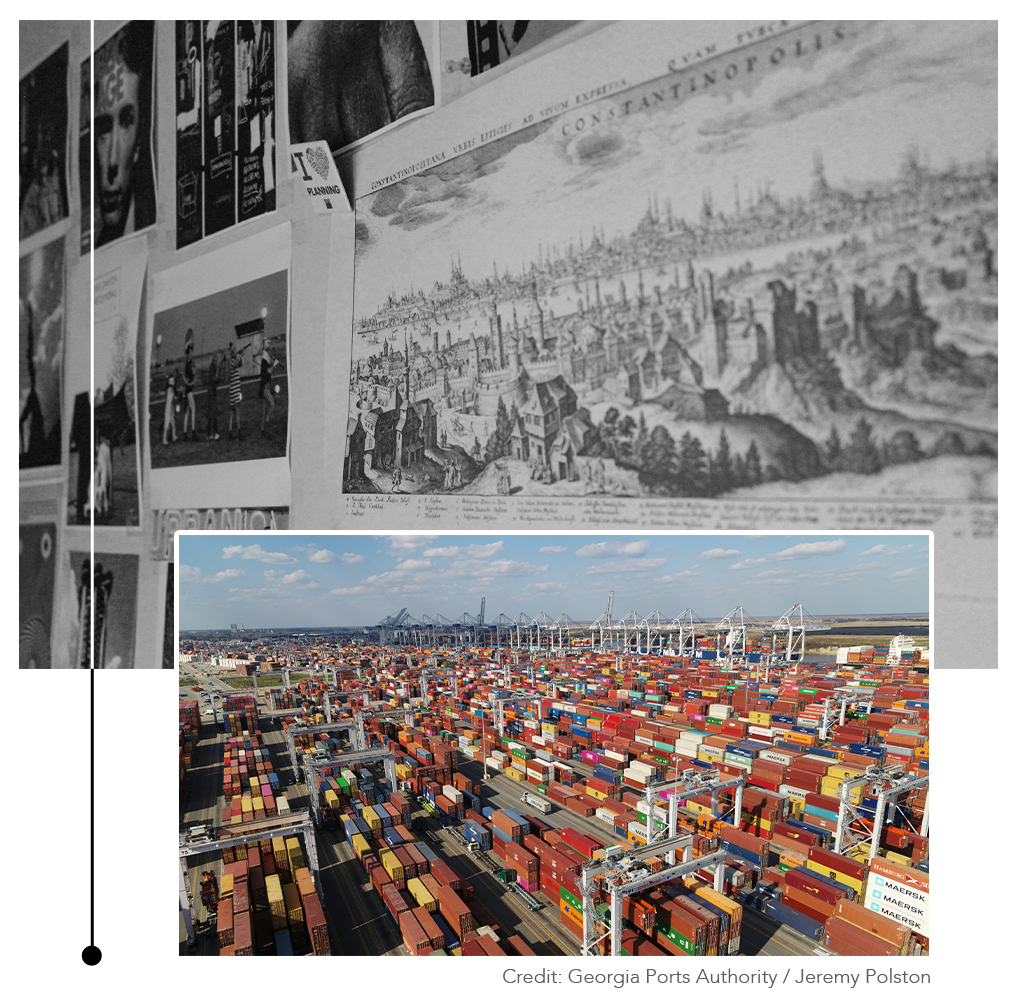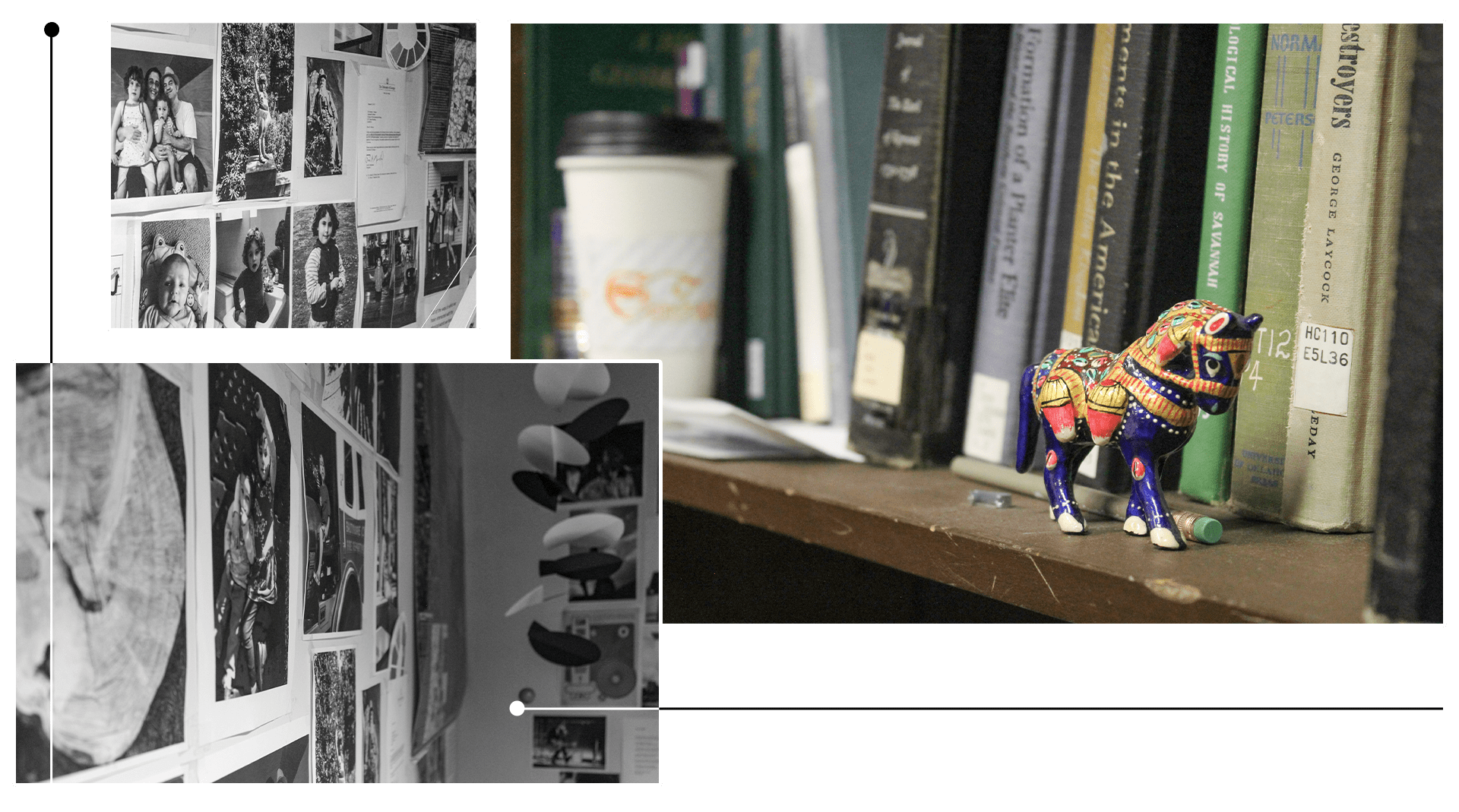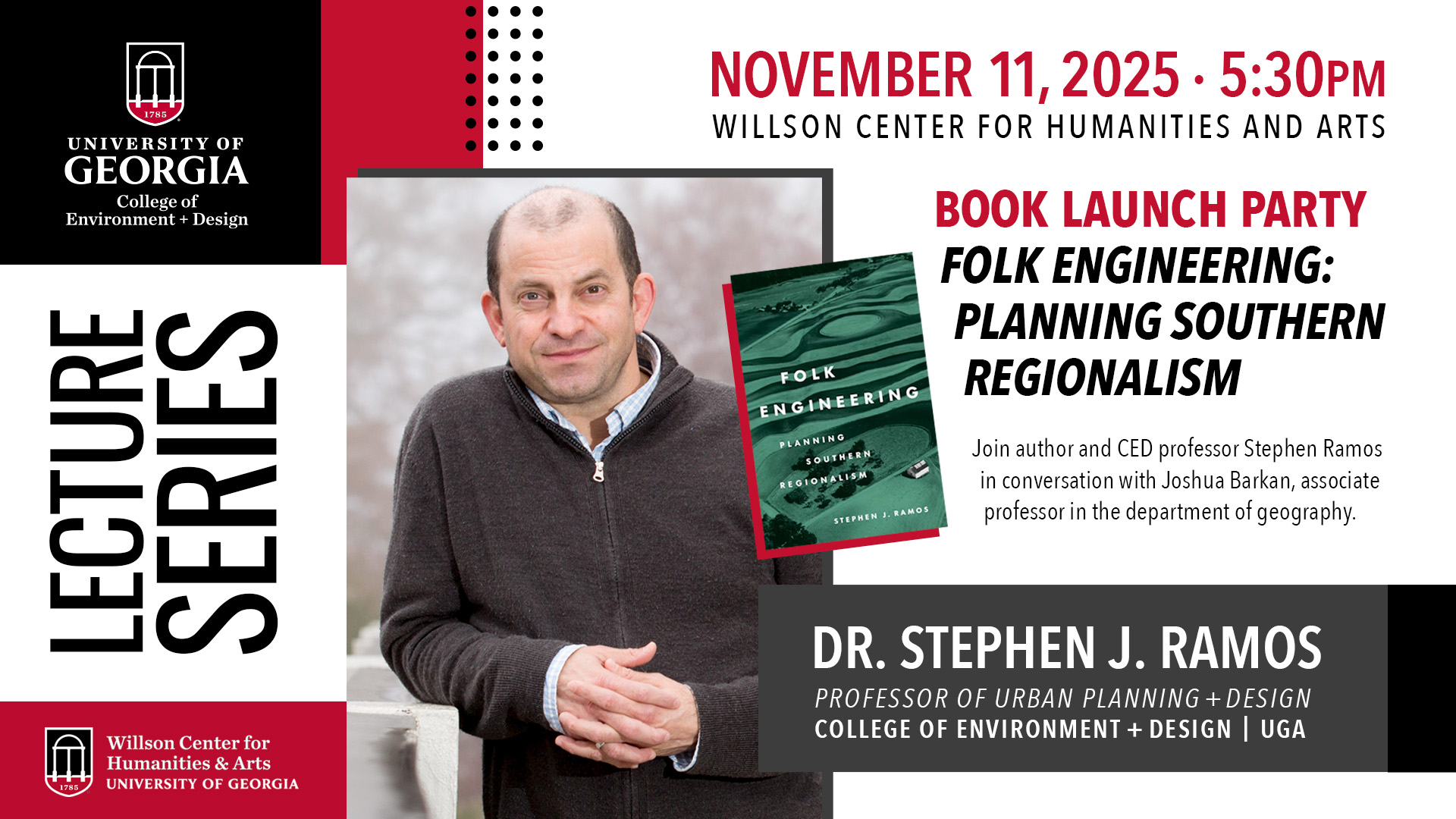Just south of downtown and tucked into the side of North Campus is the Tanner Building, home of UGA’s Master of Urban Planning and Design program. Down the stairs and within the historic brick walls is professor Stephen Ramos’ office.
A collage of prints covers the walls behind his desk, filled with everything from children’s drawings and family photos to vintage city plans and his taste for the avant-garde.
Starting at the top left corner, from left to right, Ramos points out and names the prints covering the wall.
“So, we have Aretha Franklin,” says Ramos, a professor of urban planning and design since 2011. “This is a famous sculpture by Ossip Zadkine in Rotterdam. It’s called ‘The Destroyed City,’ located at the old port. This is just some LA, X, Los Lobos, Chuck Berry, Rick Danko, the Clash.”
The list goes on. Bob Dylan, the B-52s, a poster for the film “8 1/2″ by Federico Fellini. Muhammad Ali, Andy Warhol and the famed “The Sleep of Reason Produces Monsters,” by Spanish painter Francisco Goya.
Like the wide range of work on his walls, Ramos’ interests span disciplines, genres, places and roles. While Ramos now teaches in the MUPD program, his own academic journey began with a different discipline in mind.
 A Global Foundation in Dual Disciplines
A Global Foundation in Dual Disciplines
In 1992, Ramos graduated with his bachelor’s degrees in English and Spanish from Gettysburg College.
“I first moved to the wilds of New York City,” said Ramos. “I did all kinds of things. I built off Broadway sets. I sold sofas. I taught English as a second language at the Borough of Manhattan Community College. But I was very interested in going to Latin America for the literature, art, and politics that were happening.”
One year later, Ramos moved to León, Nicaragua to work with Project Gettysburg-León, a non-profit partnership supporting sustainable development in the city. As project coordinator for the organization, Ramos worked with communities on issues of drinkable water, sewage, and housing.
“It was in many ways a deep education for me,” said Ramos. “I was put into a position of great responsibility without a lot of the tools for it. It was really a trial by fire.”
After two and a half years of living in Nicaragua, Ramos decided to pursue a Master of Latin American Studies at the University of Texas at Austin (UT). While at UT, he discovered another program that piqued his interest.
“[UT] had this subject called planning, and I wasn’t exactly sure what it was, but it sounded similar to the kinds of things we’d been doing in Nicaragua,” said Ramos. “They offered a dual program, and, in many ways, I went in as a Latin Americanist and I came out as an urban planner.”
In 2000, Ramos graduated from UT with master’s degrees in Latin American Studies and Community and Regional Planning. From there, he moved to Spain and got a job with a planning and architecture firm in Madrid.
“The work I was doing in Spain connected to knowledge networks about urban planning and design,” said Ramos. “In Madrid, the group I worked with, Fundación Metrópoli, was doing research on planning issues for this network of cities around the world.”
In Latin America and at UT, his work focused on the socio-economic and political significance of planning. But in Spain, planning and design was a more formal specialization within architectural education.
In 2005, Ramos got the opportunity to research the fields together at the Harvard University Graduate School of Design.
At Harvard, Ramos took an interest studying region and infrastructure. During his time, he co-founded the journal New Geographies and was a co-editor of Infrastructure Sustainability and Design. Following a studio trip to Dubai, Ramos decided to do his doctoral dissertation on the ports of Dubai and their impact on the metropolitan morphology of the emirate.
“I do tend to go back to the maritime aspect,” said Ramos. “There’s something about its trade protagonism, connecting the inner hinterland with the world abstracted as endless horizon.”
Born in Boston and raised outside of Baltimore, port cities are a familiar home for Ramos. He can recall watching Baltimore’s Harborplace project transform the waterfront, turning an industrial hub into a hub for entertainment and service.
“There’s something conceptually intriguing to me about the coast,” said Ramos. “You know why it is that people remain there.”
In 2009, he received his Doctor of Design from Harvard GSD.
From Ports to Pedagogy
After receiving his doctorate, Ramos continued with a post-doctoral position at the Belfer Center for Science and International Affairs at Harvard’s Kennedy School. There, he was able to turn his dissertation into his first book, Dubai Amplified: The Engineering of a Port Geography.
In 2011, Ramos and his wife made their way to Athens, Georgia. For his wife, it was a PhD in the Mary Frances Early College of Education, and for Ramos, it was an assistant professorship at the CED.
“It was clear that the College of Environment and Design at UGA was interested in physical planning and returning to studio-based physical planning pedagogy,” said Ramos. “This resonated with me in terms of how I understood urbanism and urbanism education. That was exciting, and we accepted the offer.”
At UGA, Ramos’ port-city interest led him to work on the Savannah Harbor Expansion Project, a multi-year project aimed to deepen the Savannah, Georgia’s harbor. With over $100,000 in research support from the National Oceanic and Atmospheric Administration, Ramos explored the Savannah River corridor and the economic and social claims on riparian and coastal ecology.
“When I got to Athens, I quickly started studying Savannah because it was going through a port dredging project. In my work on Dubai, I’d been interested in dredge and the geotechnical shaping of geographies,” said Ramos.
When he’s not researching, Ramos can be found teaching Master of Urban Planning and Design students in Tanner Building. In 2024, Ramos’ “Ideas of Community” class was awarded the Georgia Chapter of the American Planning Association Outstanding Student Project for their asset-based community development report for the Gwinnett County, Georgia initiative in the Community Housing category.
“The students’ perspective is the lifeline, right?” said Ramos. “It’s the lifeblood because the students are the ones who will continuously force us to reconsider those things we hold as established. Without that, we’re stagnant.”
 Folk Engineering
Folk Engineering
In addition to port cities, Ramos also studies planning history.
In the years between World War I and World War II, a new school of thought about urbanism, human ecology, and sociology emerged from a group of researchers at the University of Chicago. Their theories went on to become known as the “Chicago school” of thought.
But in the South, these ideas were emerging on their own. Sociologist and Georgia native Howard W. Odum and his team of researchers at the University of North Carolina at Chapel Hill were developing a home-grown field known as “Southern Regionalism.”
This topic is the basis of Ramos’ forthcoming book Folk Engineering: Planning Southern Regionalism, to be published in fall 2025 by the University of North Carolina Press.
In the book, Ramos explores how Odum’s concept of Southern Regionalism influenced regional planning during the interwar period, and specifically how it shaped federal New Deal policies and interacted with outmigration from the South caused by Jim Crow laws and agricultural crisis.
“The book is about how at a moment in time in the interwar years leading into the depression, regional planning was understood to have a cultural component as interpreted through the social sciences,” said Ramos.
The book looks at the tension between Odum’s pairing of regionalism, which Ramos defines as a “backward-looking nostalgic practice,” to planning, a “fundamentally forward-looking” practice.
The title, Folk Engineering, was coined by Ramos to encapsulate what Odum refers to as “folkways” with the social engineering occurring at the time. While most of the attention falls on the Chicago School, Ramos aims with his book to shine a light on the work of Odum.
“I hope it’s a contribution to an understanding of regional planning in the South during the interwar years and how it was a part of broader national and international conversations around those issues,” said Ramos.
Read more about Ramos’s forthcoming book, Folk Engineering: Planning Southern Regionalism here.
“An original and deeply researched analysis of the movement known as Southern Regionalism from the 1920s through the 1950s, centering on its best-known figure, Howard W. Odum. Stephen Ramos’s interpretation is fresh and original, his scholarship impressive, and his prose vigorous.”
– Robert Fishman, Emeritus Professor of Architecture and Urban and Regional Planning at the University of Michigan




